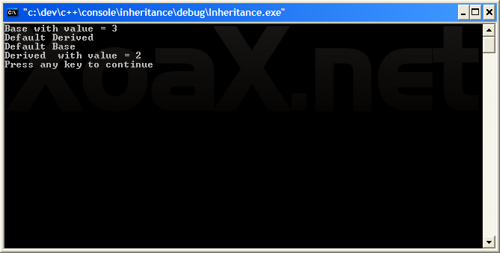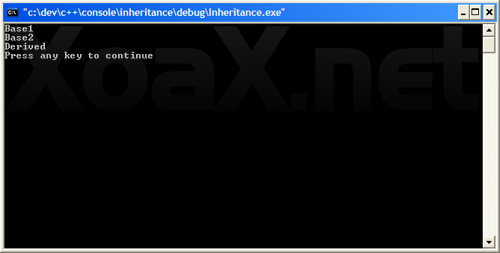Core C++
Inheritance
Simple Inheritance
Example 1
#include <iostream> // The base class has a single member variable class CBase { public: double mdBase; }; // Derived inherits the base class variable class CDerived : public CBase { public: double mdDerived; }; int main() { using namespace std; CDerived qMyObject; // The derived object has both base and derived members qMyObject.mdBase = 1.0; qMyObject.mdDerived = 2.0; cout << "Base = " << qMyObject.mdBase << endl; cout << "Derived = " << qMyObject.mdDerived << endl; return 0; }
Output:

Example 2
#include <iostream> // This base class has a single member function class CBase { public: void PrintBase() { std::cout << "Base" << std::endl; } }; // Derived inherits the base class function class CDerived : public CBase { public: void PrintDerived() { std::cout << "Derived" << std::endl; } }; int main() { using namespace std; CDerived qMyObject; // The derived object can call both functions qMyObject.PrintBase(); qMyObject.PrintDerived(); return 0; }
Output:

Constructors and Destructors
Example 1
#include <iostream> // Base class class CBase { public: CBase() { std::cout << "Base Constructor" << std::endl; } ~CBase() { std::cout << "Base Destructor" << std::endl; } }; // First derived class class CDerived1 : public CBase { public: CDerived1() { std::cout << "Derived1 Constructor" << std::endl; } ~CDerived1() { std::cout << "Derived1 Destructor" << std::endl; } }; // Second derived class inheriting the first class CDerived2 : public CDerived1 { public: CDerived2() { std::cout << "Derived2 Constructor" << std::endl; } ~CDerived2() { std::cout << "Derived2 Destructor" << std::endl; } }; int main() { using namespace std; // Instantiation calls the constructors from base to most derived. CDerived2 qMyObject; // The destructors are called in reverse order upon exit return 0; }
Output:

Example 2
#include <iostream> // Base class class CBase { public: CBase() { std::cout << "Default Base" << std::endl; } CBase(int i) { std::cout << "Base with value = " << i << std::endl; } }; // Derived class class CDerived : public CBase { public: // The base constructor is called with the argument 3 CDerived() : CBase(3) { std::cout << "Default Derived" << std::endl; } // The base default constructor called since none is specified CDerived(int i) { std::cout << "Derived with value = " << i << std::endl; } }; int main() { using namespace std; // Illustration of default and int argument constructors CDerived qDefaultObject; CDerived qIntArgObject(2); return 0; }
Output:

Multiple Inheritance
Example 1
#include <iostream> // First base class class CBase1 { public: CBase1() { std::cout << "Base1" << std::endl; } }; // Second base class class CBase2 { public: CBase2() { std::cout << "Base2" << std::endl; } }; // Derived class inherits both base classes class CDerived : public CBase1, public CBase2 { public: CDerived() { std::cout << "Derived" << std::endl; } }; int main() { using namespace std; // A derived object which inherits both bases CDerived qMyObject; return 0; }
Output:

Example 2
#include <iostream> // Base class class CBase { public: CBase() { std::cout << "Base" << std::endl; } }; // First derived class with virtual inheritance class CDerived1 : virtual public CBase { public: CDerived1() { std::cout << "Derived1" << std::endl; } }; // Second derived class with virtual inheritance class CDerived2 : virtual public CBase { public: CDerived2() { std::cout << "Derived2" << std::endl; } }; // Derived class inheriting both derived classes class CDerived3 : public CDerived1, public CDerived2 { public: CDerived3() { std::cout << "Derived3" << std::endl; } }; int main() { using namespace std; // Instantiate all three derived classes CDerived1 qMyObject1; CDerived2 qMyObject2; // Although both derived inherited classes inherit the // base, the inheritance is virtual. So, the third // derived class only inherits the base once instead // of twice. CDerived3 qMyObject3; return 0; }
Output:

© 2007–2024 XoaX.net LLC. All rights reserved.
